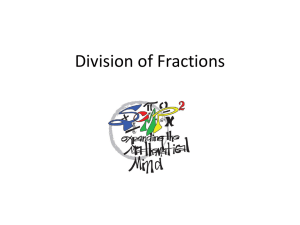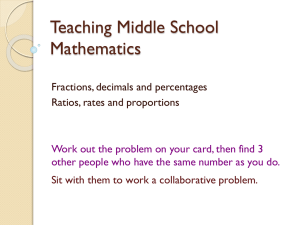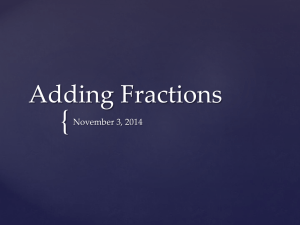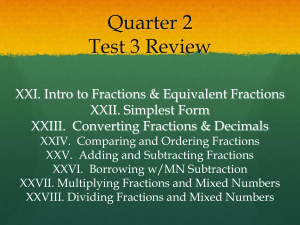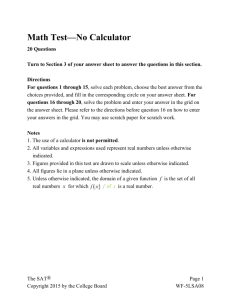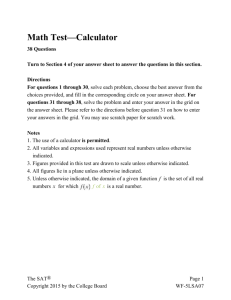Fractions less than 1 Whole, Equal to 1 Whole, or Greater than 1
advertisement
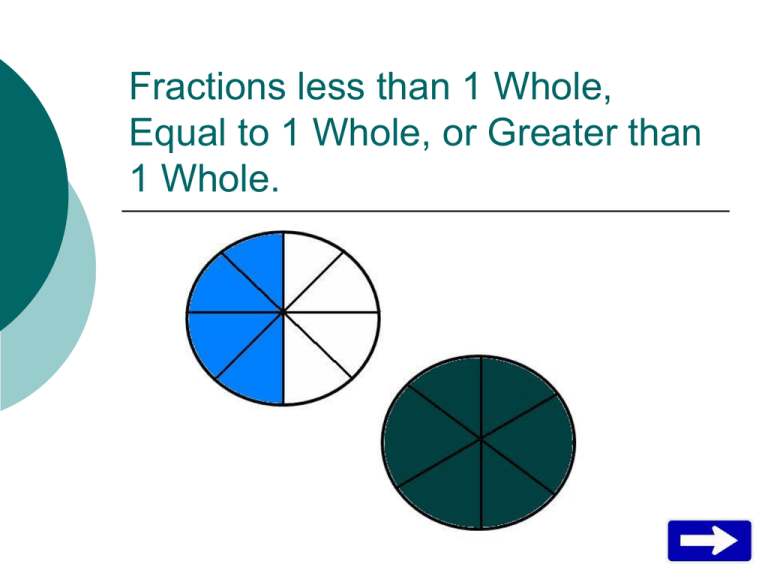
Fractions less than 1 Whole, Equal to 1 Whole, or Greater than 1 Whole. Many students think that all fractions are less than 1. Some fractions are less than 1, some are equal to 1, and others are greater than 1. Here’s how you tell how large a fraction is. Start with the bottom number. The bottom number tells you how many equal parts are in each whole group. How many parts are in each of these whole groups? 4 3 2 8 6 The top number tells how many parts we use. How many parts are shaded in each of these whole groups? ` 3 2 1 5 2 If a fraction equals 1 you use the same number of parts in each whole group. If the bottom number is 4, you use 4 parts in each group. If you had 1 whole group shaded in, how many parts would you use? That’s right, 4 parts. So the fraction 4 equals 1 whole group. 4 The fraction 4 equals 1. 4 If a fraction equals 1 you use the same number of parts in each whole group. If the bottom number is 3, you use 3 parts in each group. If you had 1 whole group shaded in how many parts would you use? Good job, 3 parts. So the fraction 3 equals 1 whole group. 3 3 equals 1. 3 If a fraction equals 1 you use the same number of parts in each whole group. If a bottom number is 8, you use 8 parts in each group. If you had 1 whole group shaded in how many parts would you use? Yes, 8 parts So the fraction 8 equals 1 whole group. 8 8 equals 1. 8 Which of the following fractions equal 1? 3 5 7 7 100 1 5 7 9 100 1 6 10 3 4 2 5 11 3 1 You can look at a fraction and tell if the number is less than 1 whole, equals 1 whole, or less than 1 whole. The bottom part tells how many parts are in each whole group. This fraction has 6 parts in each whole group. If the fraction equals 1, how many parts would we use? 6 equals 1 whole group. 6 If a fraction has 6 parts and we use more than 6 parts, then we have more than one whole group. This fraction has 8 parts. So we have more than 1 whole group. 8 is more than 1 whole group. 6 So the fraction 8 6 is more than one whole group. If a fraction has 6 parts and the top number in a fraction uses less than 6 parts, then we have less than one whole group. This fractions uses 3 parts. So we have less than one whole group. 3 is less than one whole group. 6 So the fraction 3 is less than one whole group. 6 Your Turn Identify the fractions that are less than one whole, equal to 1 whole, or greater than one whole. 1) 5 2) 1 1 2 Less 3) 4 Greater 6) 4 6 5 Greater 4) 7 Equal 7) 9 10 11 Less 5) 9 Greater 8) 7 Less 9) 100 100 Equal 3 3 Equal 10) 4 1 Greater Good Job! You have successfully completed part 2.


